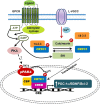PAK4 signaling in health and disease: defining the PAK4-CREB axis
- PMID: 30755582
- PMCID: PMC6372590
- DOI: 10.1038/s12276-018-0204-0
PAK4 signaling in health and disease: defining the PAK4-CREB axis
Abstract
p21-Activated kinase 4 (PAK4), a member of the PAK family, regulates a wide range of cellular functions, including cell adhesion, migration, proliferation, and survival. Dysregulation of its expression and activity thus contributes to the development of diverse pathological conditions. PAK4 plays a pivotal role in cancer progression by accelerating the epithelial-mesenchymal transition, invasion, and metastasis. Therefore, PAK4 is regarded as an attractive therapeutic target in diverse types of cancers, prompting the development of PAK4-specific inhibitors as anticancer drugs; however, these drugs have not yet been successful. PAK4 is essential for embryonic brain development and has a neuroprotective function. A long list of PAK4 effectors has been reported. Recently, the transcription factor CREB has emerged as a novel effector of PAK4. This finding has broad implications for the role of PAK4 in health and disease because CREB-mediated transcriptional reprogramming involves a wide range of genes. In this article, we review the PAK4 signaling pathways involved in prostate cancer, Parkinson's disease, and melanogenesis, focusing in particular on the PAK4-CREB axis.
Conflict of interest statement
The authors declare that they have no conflict of interest.
Figures





References
-
- Manser E, Leung T, Salihuddin H, Zhao ZS, Lim L. A brain serine/threonine protein kinase activated by Cdc42 and Rac1. Nature. 1994;367:40–46. - PubMed
-
- Manser E, Lim L. Roles of PAK family kinases. Prog. Mol. Subcell. Biol. 1999;22:115–133. - PubMed
-
- Arias-Romero LE, Chernoff J. A tale of two Paks. Biol. Cell. 2008;100:97–108. - PubMed
Publication types
MeSH terms
Substances
LinkOut - more resources
Full Text Sources
Research Materials

